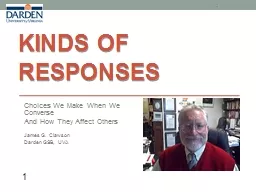PPT-Kinds of Responses
Author : kittie-lecroy | Published Date : 2017-03-25
Choices We Make When We Converse And How They Affect Others James G Clawson Darden GSB UVA 1 1 Habitual Patterns in Conversation When we converse we often fall into
Presentation Embed Code
Download Presentation
Download Presentation The PPT/PDF document "Kinds of Responses" is the property of its rightful owner. Permission is granted to download and print the materials on this website for personal, non-commercial use only, and to display it on your personal computer provided you do not modify the materials and that you retain all copyright notices contained in the materials. By downloading content from our website, you accept the terms of this agreement.
Kinds of Responses: Transcript
Download Rules Of Document
"Kinds of Responses"The content belongs to its owner. You may download and print it for personal use, without modification, and keep all copyright notices. By downloading, you agree to these terms.
Related Documents














